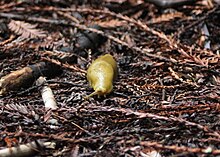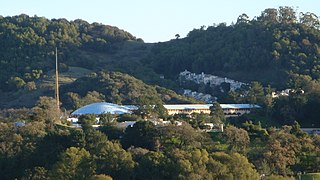
Marin County is located in the northwestern part of the San Francisco Bay Area of the U.S. state of California. As of the 2020 census, the population was 262,231. Its county seat and largest city is San Rafael. Marin County is across the Golden Gate Bridge from San Francisco, and is included in the San Francisco–Oakland–Berkeley, CA Metropolitan Statistical Area.

The Redwood National and State Parks (RNSP) are a complex of one national park and three state parks, cooperatively managed and located in the United States along the coast of northern California. Comprising Redwood National Park and California's State Parks—Del Norte Coast, Jedediah Smith, and Prairie Creek —the combined RNSP contain 139,000 acres (560 km2), and feature old-growth temperate rainforests. Located within Del Norte and Humboldt counties, the four parks protect 45 percent of all remaining coast redwood old-growth forests, totaling at least 38,982 acres (157.75 km2). The species is the tallest, among the oldest, and one of the most massive tree species on Earth. The parks also preserve other indigenous flora, fauna, grassland prairie, cultural resources, waterways, and 37 miles (60 km) of pristine coastline.

Mount Tamalpais, known locally as Mount Tam, is a peak in Marin County, California, United States, often considered symbolic of Marin County. Much of Mount Tamalpais is protected within public lands such as Mount Tamalpais State Park, the Marin Municipal Water District watershed, and National Park Service land, such as Muir Woods.
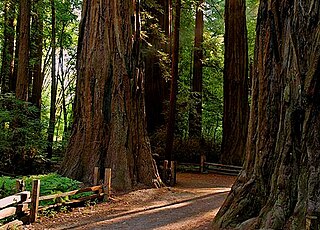
Henry Cowell Redwoods State Park is a state park of California, United States, preserving mainly forest and riparian areas in the watershed of the San Lorenzo River, including a grove of old-growth coast redwood. It is located in Santa Cruz County, primarily in the area between the cities of Santa Cruz and Scotts Valley, near the community of Felton and the University of California at Santa Cruz. The park includes a non-contiguous extension in the Fall Creek area north of Felton. The 4,623-acre (1,871 ha) park was established in 1953.

Mount Tamalpais State Park is a California state park, located in Marin County, California. The primary feature of the park is the 2,571 feet (784 m) Mount Tamalpais. The park contains mostly redwood and oak forests. The mountain itself covers around 25,000 acres (100 km2). There are about 60 miles (97 km) of hiking trails, which are connected to a larger, 200-mile (320 km) network of trails in neighboring public lands. The park received 564,000 visitors as of 2003. Muir Woods National Monument is surrounded by the state park.

Portola Redwoods State Park is a 2,800 acres (1,100 ha) state park in California situated in San Mateo County. The parks' primary watercourses — Peters Creek, Pescadero Creek and their associated tributaries — converge at Portola Redwoods State Park. Tip Toe Falls is a small waterfall along Fall Creek, a tributary of Pescadero Creek.
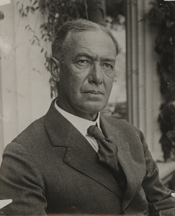
William Kent was an American politician, conservationist and philanthropist from Marin County, California. He served as a U.S. Representative from Northern California between 1911 and 1917, and was instrumental in the creation of Muir Woods National Monument.

Samuel P. Taylor State Park is a state park located in Marin County, California, United States, which includes approximately 2,700 acres (11 km2) of redwood forest and grassland. The park contains about 600 acres (2.4 km2) of old-growth forest, some of which can be seen along the Pioneer Tree Trail.

Theodore J. Hoover Natural Preserve, which includes Waddell Marsh, is located at the mouth of Waddell Creek, a coastal freshwater marsh that is one of the rarest habitats on the Central Coast of California. This marsh is one of the few relatively undisturbed bodies of fresh water left along the West coast. The land is 23 acres of wetland habitat. It is part of the Rancho del Oso Big Basin Redwoods State Park, located approximately 65 miles south of San Francisco. The elevation in the park ranges from sea level to over 2,000 feet. The area was named after William W. Waddell, who established the last of his four sawmills there in 1868. The sawmill ran down after his death in 1875. All the boilers were left in the area; they are now completely surrounded by second-growth redwoods. Other trees found in the park are conifers, and oaks. Within the park there are different vegetation types to be seen, such as chaparral, redwood forests, and riparian habitats.

The Golden Gate Biosphere Network is a voluntary coalition of federal, state, and local government agencies, nonprofit organizations, universities, and private partners within the Golden Gate Biosphere region. The Network works towards protecting the biosphere region's biodiversity and conserving its natural resources to maintain the quality of life for people within the region. The Network has been part of the UNESCO Man and Biosphere Programme since 1988 and is part of the US Biosphere Network and EuroMAB. It is recognized by UNESCO due to the significant biodiversity of the region, as well as the Network's efforts to demonstrate and promote a balanced relationship between humans and the biosphere.

The Golden Gate National Recreation Area (GGNRA) is a U.S. National Recreation Area protecting 82,116 acres (33,231 ha) of ecologically and historically significant landscapes surrounding the San Francisco Bay Area. Much of the park is land formerly used by the United States Army. GGNRA is managed by the National Park Service and is the second-most visited unit of the National Park system in the United States, with more than 15.6 million visitors in 2022. It is also one of the largest urban parks in the world, with a size two-and-a-half times that of the consolidated city and county of San Francisco.

Prairie Creek Redwoods State Park is a state park, located in Humboldt County, California, near the town of Orick and 50 miles (80 km) north of Eureka. The 14,000 acre (57 km²) park is a coastal sanctuary for old-growth Coast Redwood trees.

Lagunitas Creek is a 24 miles (39 km)-long northward-flowing stream in Marin County, California. It is critically important to the largest spawning runs of endangered coho salmon in the Central California Coast Coho salmon Evolutionary Significant Unit.

Dr. Aurelia Reinhardt Redwood Regional Park is a part of the East Bay Regional Parks District (EBRPD) in the San Francisco Bay Area. It is located in the hills east of Oakland. The park contains the largest remaining natural stand of coast redwood found in the East Bay. The park is part of a historical belt of coast redwood extending south to Leona Canyon Regional Open Space Preserve and east to Moraga.
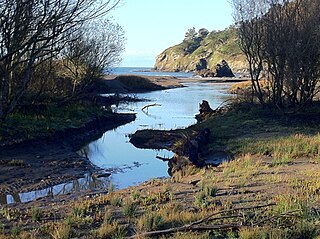
Redwood Creek is a mostly perennial stream in Marin County, California. 4.7 miles (7.6 km) long, it drains a 7-square-mile (18 km2) watershed which includes the Muir Woods National Monument, and reaches the Pacific Ocean north of the Golden Gate at Muir Beach.
Founded in 1981, the Golden Gate National Parks Conservancy is a nonprofit cooperating association that supports park stewardship and conservation in the Golden Gate National Recreation Area—the most visited national park in the U.S.

Marin Transit is a public bus agency in Marin County, California, in the United States. Originally formed in 1964 as Marin County Transit District (MCTD). Marin Transit was re-branded on 30 July 2007 and now provides a variety of fixed-route and demand-response services using contractors. In 2022, the system had a ridership of 2,628,800, or about 8,400 per weekday as of the second quarter of 2023.
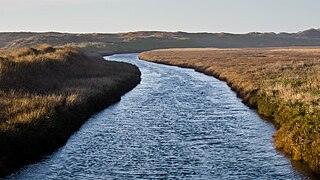
Pescadero Creek is a major stream in Santa Cruz and San Mateo counties in California, United States. At 26.6 miles (42.8 km), it is the longest stream in San Mateo County and flows all year from springs in the Santa Cruz Mountains. Its source is at 1,880 feet (570 m) above sea level on the western edge of Castle Rock State Park, with additional headwaters in Portola Redwoods State Park, and its course traverses Pescadero Creek County Park and San Mateo County Memorial Park before entering Pescadero Marsh Natural Preserve at Pescadero State Beach and thence to the Pacific Ocean 14.4 miles (23 km) south of Half Moon Bay.

Redwood Creek Native Plant Nursery was located just outside the old-growth redwood forest at Muir Woods National Monument. The nursery provided plants for restoration of the creek bank in the lower watershed and impacted areas of the Muir Woods' redwood understory. It was moved to that location in 1992, and closed in 2015.
The Watershed Alliance of Marin is a 501(c)(3) non-profit network of organizations with a shared purpose of preserving the watersheds of Marin County, California.








